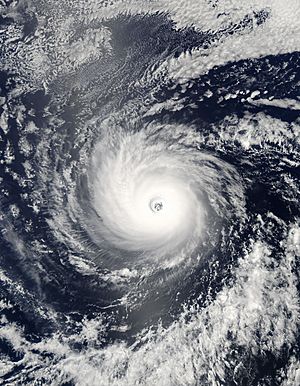Annular hurricane facts for kids

An annular hurricane is a special and rare type of tropical cyclone that forms over the ocean. You might hear this term used for storms in the northern Atlantic Ocean and the northeastern Pacific Ocean. What makes an annular hurricane unique is its shape. It has a very large, clear, and circular "eye" in the middle, which is the calmest part of the storm. Around this eye, there's a thick, strong ring of thunderstorms, called the eyewall. Unlike most hurricanes, annular hurricanes do not have the usual spiral bands of rain and clouds that swirl into their center. This special structure helps them stay strong for a longer time, even when other hurricanes might start to weaken.
Contents
What Makes an Annular Hurricane Special?
Annular hurricanes are different from typical hurricanes in a few key ways. Their unique features help them keep their strength.
A Clear, Round Eye
- Big and Symmetrical: The eye of an annular hurricane is usually much larger and more perfectly round than the eye of a regular hurricane. It looks very symmetrical from space.
- No Spirals: Most hurricanes have "rainbands" that spiral outwards from the center, like the arms of a pinwheel. Annular hurricanes don't have these. Instead, they have a solid, strong ring of clouds and thunderstorms right around the eye.
Strong and Stable Eyewall
- Thick Ring of Storms: The eyewall of an annular hurricane is very thick and strong. It's like a solid wall of powerful thunderstorms surrounding the calm eye.
- Resistant to Change: This strong eyewall makes the hurricane very stable. It means the storm is less likely to go through something called an "eyewall replacement cycle." This is when a new eyewall forms outside the old one, which can temporarily weaken a hurricane. Annular hurricanes usually avoid this, helping them stay intense.
Why They Stay Stronger Longer
- Less Affected by Wind Shear: Wind shear is when winds change speed or direction as you go higher in the atmosphere. High wind shear can tear apart a hurricane. Annular hurricanes are often more resistant to wind shear, which means they can keep their shape and strength even when conditions aren't perfect.
- Warm Ocean Water: These storms usually form over very warm ocean waters, which provides a lot of energy for them to grow and stay powerful.
How Annular Hurricanes Form
Annular hurricanes are quite rare. Scientists are still studying exactly why some hurricanes become annular while others don't. However, they usually form under specific conditions.
Ideal Conditions for Formation
- Warm Water: They need very warm ocean water, usually at least 26.5 degrees Celsius (80 degrees Fahrenheit), that goes deep below the surface. This provides the fuel for the storm.
- Low Wind Shear: As mentioned, low wind shear is important. When there isn't much change in wind speed or direction with height, the storm can build a tall, symmetrical structure without being tilted or torn apart.
- Moist Air: The air around the storm needs to be very moist, so there's plenty of water vapor to form clouds and thunderstorms.
Development Process
A regular hurricane might start to become annular if it stays in an area with these ideal conditions for a long time. The storm's inner core becomes very strong and organized, and the outer spiral bands might disappear as all the energy focuses into the central eyewall.
Impact and Importance
Because annular hurricanes can maintain their strength for longer periods, they can be very dangerous. They might stay as major hurricanes (Category 3 or higher) for many days, which gives them more time to cause damage if they make landfall. Studying these unique storms helps scientists better understand how hurricanes work and how to predict their behavior.
Images for kids
-
Satellite image of Hurricane Isabel of 2003, displaying a large, circular, and symmetric eye, and symmetrical storm shape, which are characteristics of annular tropical cyclones. Isabel is also exhibiting a pinwheel eye, a rare feature found in some annular tropical cyclones.
See also
 In Spanish: Huracán anular para niños
In Spanish: Huracán anular para niños




